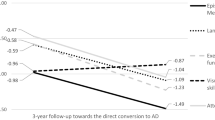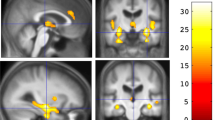Abstract
Results of a placebo controlled cross-over trial (N=89) of the anticholinesterase drug THA as a treatment for dementia of the Alzheimer's type (DAT) are reported, with reference to previous trials of the drug and the cholinergic hypothesis of aging and dementia. Using computerised tests sensitive to specific aspects of memory and attention, evidence is found for improvements in attentional function rather than memory, in patients with mild to moderate DAT. Although these improvements were significant, they were small and restricted to certain tests of attentional function. Nevertheless, they add to the growing body of evidence that the cholinergic system is involved in the control of attentional processes. The results will be relevant to future investigations into the therapeutic effects of enhancement of the cholinergic system in DAT sufferers.
Similar content being viewed by others
References
Beller SA, Overall JE, Swann AC (1985) Efficacy of oral physostigmine in primary degenerative dementia: a double-blind study of response to different dose level. Psychopharmacology 87:147–151
Benton AL (1974) Revised visual retention test, clinical and experimental applications. The Psychological Corporation, New York
Berg EA (1948) A simple objective test for measuring flexibility in thinking. J Gen Psychol 39:15–22
Blessed G, Tomlinson BE, Roth M (1968) The association between quantitative measurements of dementia and the senile changes in the cerebral grey matter of elderly subjects. Br J Psychiatry 114:797–811
Chatellier G, Lacomblez L (1990) Tacrine (tetrahydroaminoacridine; THA) and lecithin in senile dementia of the Alzheimer type: a multicentre trial. Groupe Francais d'Etude de la Tetrahydroaminoacridine. BMJ 300:495–499
Christie JE, Shering A, Ferguson J, Glen AIM (1981) Physostigmine and arecoline: effects of intravenous infusions in Alzheimer presenile dementia. Br J Psychiatry 138:46–50
Downes JJ, Roberts AC, Sahakian BJ, Evenden JL, Morris RG, Robins TG (1989) Impaired extra-dimensional shift performance in medicated and unmedicated Parkinson's disease: evidence for a specific attentional dysfunction. Neuropsychologia 27:1329–1343
Drachman DA, Sahakian BJ (1979) Effects of cholinergic agents on human learning and memory. In: Barbeau A, Growdon JH, Wurtman RJ (eds) Nutrition and the brain, vol 5. Raven Press, New York, pp 351–366
Drachman DA, Noffsinger D, Sahakian BJ, Kurdziel S, Fleming P (1980) Aging, memory, and the cholinergic system: A study of dichotic listening. Neurobiol Aging 1:39–43
Drukarch B, Kits KS, Van-der-Meer EG, Lodder JC, Stoof JC (1987) 9-Amino-1,2,3,4-tetrahydroacridine (THA), an alleged drug for the treatment of Alzheimer's disease, inhibits acetylcholinesterase activity and slow outward K+ current. Eur J Pharmacol 141:153–157
Dunnett SB, Everitt BJ, Robbins TW (1991) The basal forebrain-cortical cholinergic system: interpreting the functional consequences of excitotoxic lesions. TINS 14 [11]:494–501
Eagger SA, Levy R, Sahakian BJ (1991a) Tacrine in Alzheimer's disease. Lancet 337:989–992
Eagger SA, Morant NJ, Levy R (1991b) Parallel group analysis of the effects of Tacrine versus placebo in Alzheimer's disease. Dementia 2:207–211
Eagger SA, Morant NJ, Levy R, Sahakian BJ (1992) Tacrine in Alzheimer's disease. Time course of changes in cognitive function and practice effects. Br J Psychiatry 160:36–40
Folstein MF, Folstein SE, McHugh PR (1975) “Mini-Mental State”: a practical method for grading the cognitive state of patients for the clinician. J Psychiatr Res 12:189–198
Francis PT, Palmer AM, Sims NR, Bowen DM, Davison AN, Esiri MM, Neary D, Snowdon JS, Wilcock GK (1985) Neurochemical studies of early onset Alzheimer's disease: possible influence on treatment. N Engl J Med 313:7–11
Gauthier S, Bouchard R, Lamontagne A, et al. (1990) Tetrahydroaminoacridine-lecithin combination treatment in patients with intermediate-stage Alzheimer's disease. Results of a Canadian double-blind, crossover, multicenter study. N Engl J Med 322:1272–1276
Hills M, Armitage P (1979) The two-period cross-over clinical trial. Br J Clin Pharmacol 8:7–20
Hodkinson HM (1972) Evaluation of a mental test score for the assessment of mental impairment in the elderly. Age Ageing 1:233–239
Hughes CP, Berg L, Danziger WL, Coben LA, Martin RL (1982) A new clinical scale for the staging of dementia. Br J Psychiatry 140:566–572
Kaul P (1992) Enzyme inhibiting action of tetrahydroaminoacridine and its structural fragments. J Pharm Pharmacol 14:243–248
Kendrick DC (1985) Kendrick cognitive tests for the elderly. NFER-Nelson, Windsor, Berks
Lawton MP, Brody EM (1969) Assessment of older people: self-monitoring and instrumental activities of daily living. Gerontologist 9:179–186
McKhann G, Drachman D, Folstein M, Katzman R, Price D, Stadlan EM (1985) Clinical Diagnosis of Alzheimer's disease: Report of the NINCDS-ADRDA Work Group under the auspices of the Department of Health and Human Services Task Force on Alzheimer's Disease. Neurology 34:939–944
Molloy DW, Guyatt H, Wilson DB, Duke R, Rees L, Singer J (1991) Effect of tetrahydroaminoacridine on cognition, function and behaviour in Alzheimer's disease. Can Med Assoc J 144:29–34
Muir JL, Dunnett SB, Robbins TW, Everitt BJ (1992) Attentional functions of the forebrain cholinergic systems: effects of intraventricular hemicholinium, physostigmine, basal forebrain lesions and intracortical grafts on a multiple-choice serial reaction time task. Exp Brain Res 89:611–622
Nelson HE (1982) National adult reading test manual. NFER-Nelson; Windsor, Berks
Perry EK, Tomlinson BE, Blessed G, Bergman K, Gibson PH, Perry RH (1978) Correlations of cholinergic abnormalities with senile plaques and mental test scores in senile dementia. BMJ 2:1457–1459
Perry EK, Smith CJ, Court JA, Bonham JR, Rodway M, Atack JR (1988) Interaction of 9-amino-1,2,3,4-tetrahydroaminoacridine (THA) with human cortical nicotinic and muscarinic receptor binding in vitro. Neurosci Lett 91:211–216
Robbins TW, Everitt BJ, Marston HM, Wilkinson J, Jones GH, Page KJ (1898) Comparative effects of ibotenic acid- and quisqualic acid-induced lesions of the sustantia innominata on attentional function in the rat: further implications for the role of the cholinergic neurons of the nucleus basalis in cognitive processes. Behav Brain Res 35:221–240
Rosen WG, Mohs RC, Davis KL (1984) A new rating scale for Alzheimer's disease. Am J Psychiatry 141:1356–1364
Roth M, Tym E, Mountjoy C et al. (1986) CAMDEX: a standardised instrument for the diagnosis of mental disorder in the elderly with special reference to the early detection of dementia. Br J Psychiatry 149:698–709
Rusted JM, Warburton DM (1988) The effects of scopolamine on working memory in healthy young volunteers. Psychopharmacology, 96:145–152
Sahakian BJ (1988) Cholinergic drugs and human performance. In: Iversen LL, Iversen SD, Snyder SH (eds) Handbook of psychopharmacology, vol 20. Plenum Press, New York, pp 393–424
Sahakian BJ, Morris RG, Evenden JL, Heald A, Levy R, Philpot M, Robbins TW (1988) A comparative study of visuospatial memory and learning in Alzheimer-type dementia and Parkinson's disease. Brain 111:695–718
Sahakian BJ, Jones G, Levy R, Gray J, Warburton D (1989) The effects of nicotine on attention, information processing and short-term memory in patients with dementia of the Alzheimer type. Br J Psychiatry 154:797–800
Sahgal A, Keith AB, Lloyd (1990) Effects of nicotine, oxotremorine and 9-amino 1,2,3,4-tetrahydroacridine (tacrine) on matching and non-matching to position in rats: no evidence for mnemonic enhancement. J Psychopharmacol 4:210–218
Summers WK, Majovski LV, Marsh GM, Tachiki K, Kling A (1986) Oral tetrahydroaminoacridine in long-term treatment of senile dementia, Alzheimer type. N Engl J Med 315:1241–1245
Warburton DM, Brown K (1971) Attenuation of stimulus sensitivity induced by scopolamine. Nature 230:126–127
Warburton DM, Brown K (1972) The facilitation of discrimination performance by physostigmine sulphate. Psychopharmacologia 27:275–284
Wechsler D (1955) Manual for the Wechsler Adult Intelligence Scale. The Psychological Corporation, New York
Wechsler D, Stone CP (1973) Manual Wechsler Memory Scale. The Psychological Corporation (copyright The Journal Press), New York
Author information
Authors and Affiliations
Rights and permissions
About this article
Cite this article
Sahakian, B.J., Owen, A.M., Morant, N.J. et al. Further analysis of the cognitive effects of tetrahydroaminoacridine (THA) in Alzheimer's disease: assessment of attentional and mnemonic function using CANTAB. Psychopharmacology 110, 395–401 (1993). https://doi.org/10.1007/BF02244644
Received:
Revised:
Issue Date:
DOI: https://doi.org/10.1007/BF02244644




